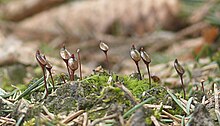Leafless goblin moss
| Leafless goblin moss | ||||||||||||
|---|---|---|---|---|---|---|---|---|---|---|---|---|

Leafless goblin moss ( Buxbaumia aphylla ) |
||||||||||||
| Systematics | ||||||||||||
|
||||||||||||
| Scientific name | ||||||||||||
| Buxbaumia aphylla | ||||||||||||
| Hedw. |
The leafless goblin moss ( Buxbaumia aphylla ) or horse hoof moss is a deciduous moss species from the Buxbaumiaceae family .
description
The moss is one of the strangest native species of moss and has become known even among non-bryologists. The plants grow singly or in small herds. As with other Buxbaumia species, only the sporophytes are conspicuous; plants without developed sporophytes are practically impossible to find due to the greatly reduced gametophytes . The genus Buxbaumia has thus undergone a remarkable parallel development to other deciduous moss genera and is more similar to the higher plants, whose gametophyte is also greatly reduced.
The 5-6 mm large, asymmetrical spore capsule is carried by a 0.5 to 1 cm long, upright, plump, red to orange-brown seta . The sporophyte photosynthesis on the green, flattened side of the capsule and is turned towards the sun like a collector. The main supply of the sporophytes takes place via the mother plant on the foot, which obtains the appropriate nutrients via a mycorrhizal fungus .
The formation of the sporophyte begins in late autumn, around October and continues until spring. The spore ripening takes place in spring to early summer. The spores are spread via a bellows mechanism in which the spores are blown out through the small, pointed opening on the sporogon by the impact of raindrops.
Location claims and distribution
Unlike the green goblin moss, it grows in a sunny location and is primarily a moss of the colline to montane level. It prefers lime-free, sandy-loamy, rutted and often lichen-rich slopes at the edges of paths and forests. The locations are partially shaded to full sun and mostly alternately humid. As a classic pioneer moss, the less competitive species prefers open and sparsely vegetated areas. Deadwood is seldom settled. Accompanying mosses and lichens are mainly other pioneer species of the genera Cephaloziella , Cladonia , Funaria , Peltigera and Polytrichum .
Hazard and protection
The species has so far been detected in all federal states, but is only found very scattered. A reliable statement about the actual degree of danger can only be made after several years of systematic recording of the occurrences. The moss is currently classified as endangered for Germany in the Red List.
literature
- Jan-Peter Frahm , Wolfgang Frey : Moosflora (= UTB . 1250). 4th, revised and expanded edition. Ulmer, Stuttgart 2004, ISBN 3-8252-1250-5 .
